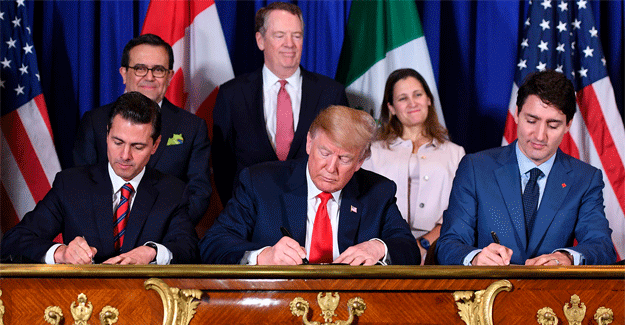
USMCA Deal Now In Action
As business and industry trumpet the start of North America's new trade agreement this month, the road ahead is lined with both possibilities and challenges, experts on multinational trade said. All three countries now must put in the hard work required to advance the largest tariff-free trading bloc on the globe, they said. "North America's new regional trade agreement has the potential to propel each of the three member countries individually, and the region collectively, to the highest levels of international competitiveness," said Duncan Wood, an internationally known specialist on North American politics and the director of the Wilson Center's Mexico Institute in Washington D.C. "Now what we have to consider is how each of the three governments is going to do its job making sure we have the right regulations in place, the right legislation in place, and that we can work with business to take full advantage of this." Globe's largest tariff-free trading bloc Since NAFTA's inception, annual American trade with the two countries has nearly quadrupled to $1.3 trillion, and they purchase more than one-third of US merchandise exports, according to statistics compiled by the US Chamber of Commerce. Today, trade with Canada and Mexico support nearly 14 million American jobs, and nearly 5 million of these jobs are supported by the increase in trade generated by free trade. A win for Arizona industry A 2019 report by the Arizona Chamber of Commerce & Industry, the Arizona Chamber Foundation and the Arizona-Mexico Commission, found that between 2015-2017 Arizona exported $10.5 billion annually to Canada and Mexico. More than 228,000 jobs in Arizona are dependent on the annual trade and investment relationship. Arizona is now well positioned to continue to attract new manufacturing and supply chains, Wood said. The introduction of digital and e-commerce into the trade agreement should strengthen Arizona and North America's competitive edge in global markets with a new emphasis on digital trade and ecommerce, fewer barriers to trade, joint production and the strengthening of existing supply chains, experts said. Among the benefits cited:
- Raises the "de minimis" customs thresholds under which US businesses may export to Canada and Mexico with reduced paperwork and without paying taxes or duties
- Reduces red tape at the border, reduces costs, and increases predictability for cross-border transactions
- Gives preferential market access for US agricultural exporters, and commitments to fair and science-based trade rules
- Opens up new market opportunities for US dairy and fruit farmers in Canadian markets
- Introduces agricultural biotechnology into the agreement including support for innovation including new technologies such as gene editing
- Introduces a chapter for the first time to support expanded trade for small- and medium-size businesses
Textile Excellence
If you wish to Subscribe to Textile Excellence Print Edition, kindly fill in the below form and we shall get back to you with details.








